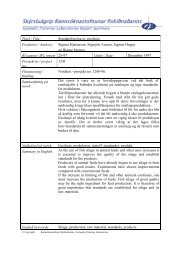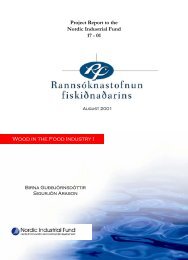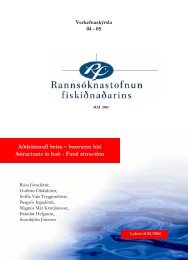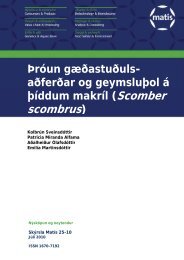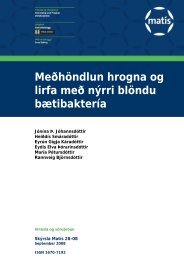Microbiology and Spoilage Trail in Nile Perch (Lates niloticus), Lake ...
Microbiology and Spoilage Trail in Nile Perch (Lates niloticus), Lake ...
Microbiology and Spoilage Trail in Nile Perch (Lates niloticus), Lake ...
You also want an ePaper? Increase the reach of your titles
YUMPU automatically turns print PDFs into web optimized ePapers that Google loves.
Accord<strong>in</strong>g to Cornell, (1975), the primary oxidation products are lipid hydroperoxides. In<br />
the later stages of oxidation secondary oxidation products usually may be present <strong>and</strong> thus<br />
be <strong>in</strong>dicative of a history of autoxidation. These products consist of aldehydes, ketones,<br />
short cha<strong>in</strong> fatty acids <strong>and</strong> others, many of which are characterised by unpleasant odours<br />
<strong>and</strong> flavours associated with oxidized fish lipids.<br />
2.4 STAGES OF SPOILAGE FOR ICED FRESH FISH<br />
The spoilage starts as soon as the fish dies due to series of chemical, physical,<br />
bacteriological, <strong>and</strong> histological changes that occur <strong>in</strong> the muscle tissue, (Emilia <strong>and</strong><br />
Santos, 1996). When fish is be<strong>in</strong>g caught it uses a lot of energy from limited glycogen<br />
compound <strong>in</strong> the course of struggle to survive. The defensive power is reduced follow<strong>in</strong>g<br />
depletion of glycogen <strong>in</strong> the muscles of fish. Depletion of glycogen limits the degree of<br />
post mortem acidification of the tissue; hence the pH rema<strong>in</strong>s between 6.2-6.5 as compared<br />
to around pH 5.5 for red meat. The pH is generally reduced due to the formation of lactic<br />
acid from glycogen which plays a role on retard<strong>in</strong>g the growth of bacteria like <strong>in</strong> the case of<br />
the red animal meat. Therefore majority of fish spoil fast due to the favourable pH which<br />
supports the activity <strong>and</strong> growth of microorganisms. However prolonged keep<strong>in</strong>g quality<br />
has been observed to fish which have low pH such as halibut which has approximately pH<br />
5.6, (Adams <strong>and</strong> Mourice (2008). On the other h<strong>and</strong>, fish like halibut which conta<strong>in</strong>s<br />
natural fats <strong>in</strong> the form of phospholipids <strong>and</strong> is rich <strong>in</strong> trimethylam<strong>in</strong>e oxide (TMAO) can<br />
also be more vulnerable to fast spoilage compared to lean fish. The fish-fat is usually<br />
highly unsaturated <strong>and</strong> it is easily oxidized (Santos-Yap, 1995). The rapid deterioration or<br />
spoilage of fresh fish as opposed to other high prote<strong>in</strong> muscle foods is due to the large<br />
concentration of non prote<strong>in</strong> nitrogen (NPN) compounds <strong>in</strong> fish muscles. Usually there are<br />
about four stages of fish spoilage as categorized by the number of storage days <strong>in</strong> melt<strong>in</strong>g<br />
ice. Start<strong>in</strong>g from; 0-5 days, 5-10 days, 10-14, <strong>and</strong> after 14 days, <strong>in</strong> the follow<strong>in</strong>g table 5.<br />
16




